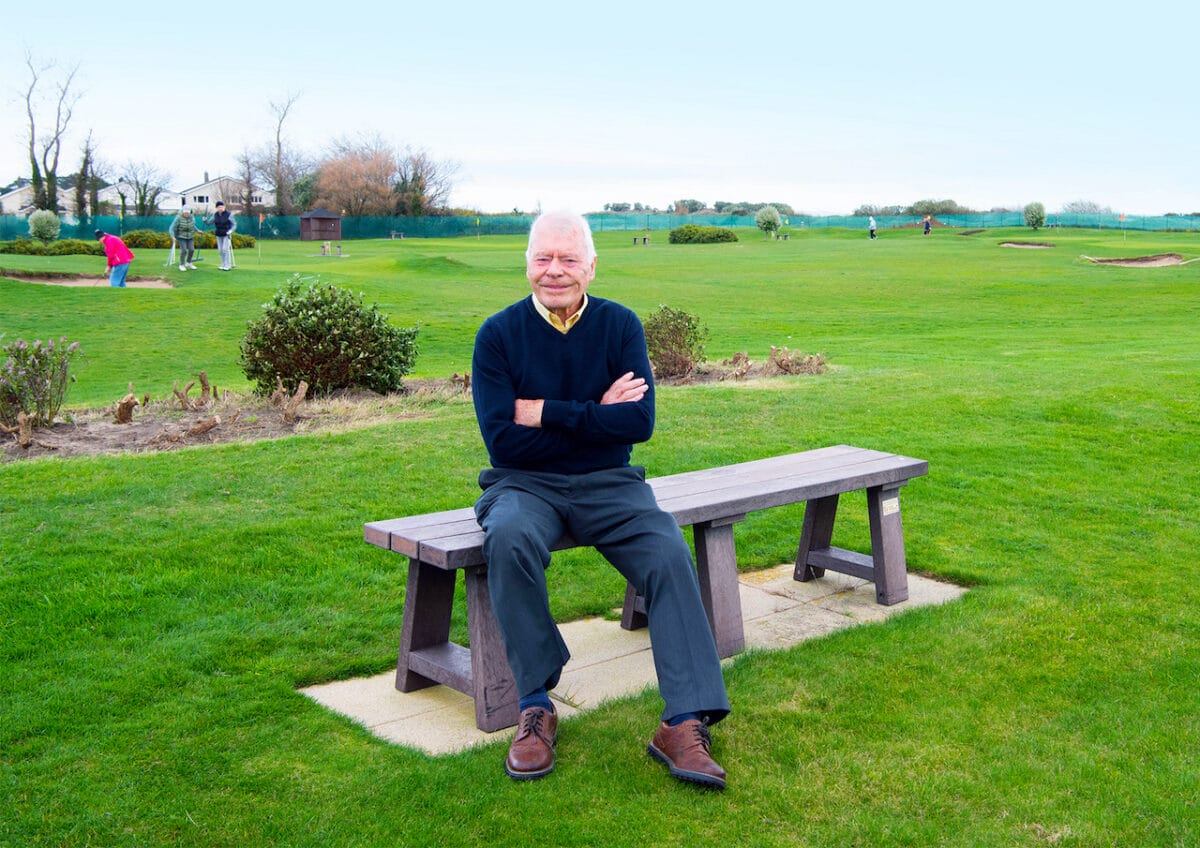The long arm of coincidence reached out and gave me a tap on the shoulder recently.
While researching for my article on Niall Quinn’s football career and his involvement in golf for Irish Golfer Magazine recently, I came across a piece I wrote during the Irish Open of 2003. The subject was Joe Sheridan, a prominent member of The Island golf club.
He had an intriguing tale of caddying at Portmarnock GC as a youngster, particularly of the tradition of rewarding the caddie who was first to collect the Captain’s golf ball from the annual drive-in.
Reading it, I wondered: What had become of Joe since we spoke that week? That Open at Portmarnock – Kiwi Michael Campbell won it – was 19 years ago. Joe wasn’t a young man then, and truth be told, I wondered was he still alive?
Lo and behold, a few days later, completely out of the blue and nothing to do with me, a link to that Irish Independent article of 2003 was put up on the Portmarnock pitch and putt club’s What’s App by member Garry O’Connor.
Turns out not only was Joe still around, he retained an impressive level of fitness at the ripe old age of 86. He had shot 36 points around The Island off 22 handicap the previous week and is actively involved with the Portmarnock P & P as President of the club.
Now that is impressive. It reminded me of Joe’s story which harkens back to a long gone era when caddying offered much needed coinage and an introduction to the golf for kids who would not otherwise have sampled its delights.
The Irish Open link was particularly relevant for Joe. Back in 1946 he was ten years of age when given the task of being a fore-caddie for Fred Daly at the first post-World War 2 staging of our national Open. Huge crowds flocked to Portmarnock to see the stars from home and abroad with the popular Daly among the favourites.
Joe’s job was simple: “Go ahead of your player and make sure to spot the ball for him. In those days your eyes were sharp as a cat and you had no trouble seeing the ball.
“Fred Daly’s actual caddie was a man named Stephen McCabe from Baldoyle. Fred was a small man, very quiet, but I recall he had a habit of whistling quietly while he walked around.
“I just concentrated on keeping my eye on the ball on every shot Fred played, but I do remember the likes of Dai Rees, Ernie Whitcombe, and Bobby Locke. They were huge names to us, just as the stars of today are to modern kids,” he said.
Interesting to note that Whitcombe had won the Irish Open in 1935. Locke claimed the Irish title in 1938 and was to go on to win The Open Championship four times, the first in 1949. Welshman Rees, a multi-winner of professional tournaments and Ryder Cup player, was to win the Irish Open in 1948.
He captained the then GB & Ireland 1957 Ryder Cup team, on which Christy O’Connor Senior played, when they defeated USA for the first time since 1933. All of which underlines the quality of player in the immediate post-War years.
However good the overseas contingent were, they had no answer to Fred Daly’s form that week. Daly shot 288 to win by four from Bobby Locke and became the first Irish winner of the national Open since it was first played in 1927.
His young fore-caddie was delighted to see “his” man triumph, albeit as he said “The crowds were very big, but at the time I was just a kid and a lot of the fuss went over my head.”
Daly broke that Irish Open barrier and in 1947 followed up with another landmark achievement by winning The Open Championship at Hoylake.
While Daly was staking his claim to be Ireland’s best golfer at that time, the young Joe Sheridan had more prosaic matters on his mind, such as graduating from fore-caddie for a champion golfer to bag-carrier for members of Portmarnock.
One of the big days was the captain’s drive-in at the venerable links. Joe’s most memorable moment came in 1950.
JJ “Jack” Kelly was the captain that year. The tradition was for a small cannon to be fired, and then the captain would drive off.
In those days the first fairway would be lined on both sides by caddies. The first one to get the captain’s ball when it came to rest would earn himself the princely sum of ten shillings.
To put it in perspective, Joe was earning one shilling and nine pence per round as a caddie with tip optional, so this was a big prize. By good fortune, Joe had caddied for Jack Kelly the day before the drive-in. On the first hole the incoming captain had sliced his drive into a bunker on the right side of the fairway. Joe gambled that the captain would do the same at the drive-in and positioned himself at the back of the bunker.
As predicted, the ball came flying down and landed in the sand. Joe jumped in to claim it, but a bigger, older, caddie contested the issue and left him bloodied, with clothes torn, but unbowed. He hung on to the ball, albeit crying and battered, and went back to the captain.
“He was shocked. He couldn’t have been kinder. He took me into the clubhouse – at the time caddies were only allowed in once a year on Caddie’s Day – cleaned me up, gave me £1 instead of the ten shillings, and best of all, a whole bottle of orange squash,” said Joe.
It’s fascinating to look now at any kid who shows an interest in golf.
Get down to McGuirk’s, parents buy a set of kids branded clubs, get them lessons, have them join the juvenile section of a club, and off they go with dreams of following Rory McIlroy & Co into the ranks of riches and stardom.
Great. Far better to draw young boys and girls into the great outdoors and the golfing arena than have them hanging around playing computer games all day.
For the likes of Joe Sheridan in the Forites and Fifties, the options were extremely limited.
“I lived in the Hole In The Wall (Balgriffin) at the time. It was nearly a three mile walk if we didn’t get a lift,” he said. “Going home, if the tide was out you might go across the slob lands to Moyne Road but your clothes could be filthy, and you’d go into the Moyne river to wash yourself off and put your clothes back on.
“My mother didn’t know half the time what we were up to or she wouldn’t have let me near it,” he said.
Occasionally golfers en route to playing at Portmarnock would spot a couple of the youngsters and drive them to the club. It was a much appreciated saving on the legs before lugging a golf bag around for a couple of hours.
“It was all country roads then, not like it is now. I remember lots of times getting a lift from people like Sean Lemass and John A Costello,” he said.
Lemass was to become Taoiseach from 1959 to 1966; Costello was Taoiseach from 1948 to ’51 and from 1954 to 1957. Both men enjoyed their golf and often played at Portmarnock, albeit they were also members of Skerries GC. Lemass had joined Skerries in 1932, was captain in 1938 and later served as President of the club.
Joe has a fond memory of being brought with fellow caddie Bernard Rogers (RIP), a member of the renowned golf and pitch and putt Rogers clan of Portmarnock, to carry the bags of Lemass and Dr Gerry Owens at Skerries.
Gerry Owens, also a Skerries member, won the Irish Close title in 1939 and played 22 times for Ireland. He was GUI President in 1971.
“That was a great day. When we got to Skerries we were treated like royalty,” said Joe.
His own connection with the game has endured for almost eight decades. One of the original members of Portmarnock pitch and putt club, he remains an enthusiastic participant of the short game.
On the golf front, he joined The Island in 1968. His lowest handicap was seven, – he’s now off 22 – and he plays off seven in pitch and putt. Joe spent his working life as a Sound Technician in RTE, all of it in radio.
“RTE was a great place to work. Most of my time was Outside Broadcasts for radio. We covered everything – sport, Church services, concerts, céili houses – it was a small group in radio.
“As a technical person one day you’d be a mass in morning and afternoon you might be in Croke Park covering a match. I well remember working with Philip Greene (renowned Soccer commentator) and people like that.
“It was very parochial and people thought because it was RTE you didn’t work hard, but I know I did because you’re hauling around heavy gear.
“The audio mixers they had in my day were nearly four stone in weight for a four-channel mixer. Now you see a 12 channel mixer and you’d pick it up in your hand. It’s like a mobile phone.
“But it was all very enjoyable. And I’m still enjoying getting out at The Island and the Portmarnock pitch and putt course,” he said.























Leave a comment